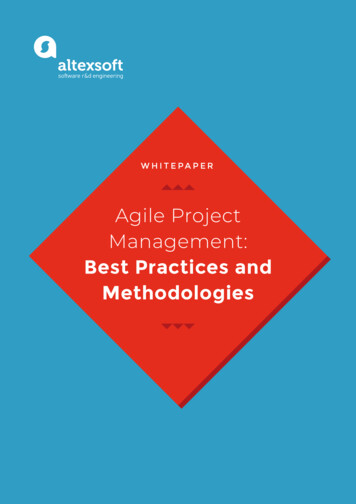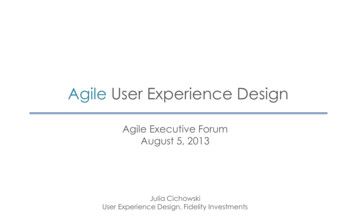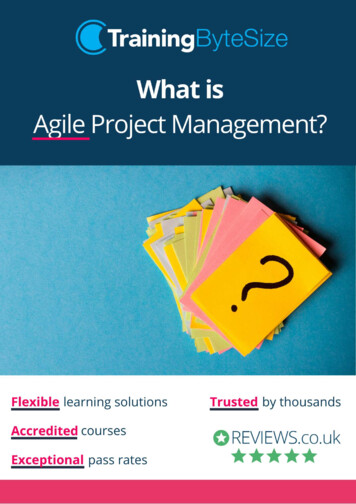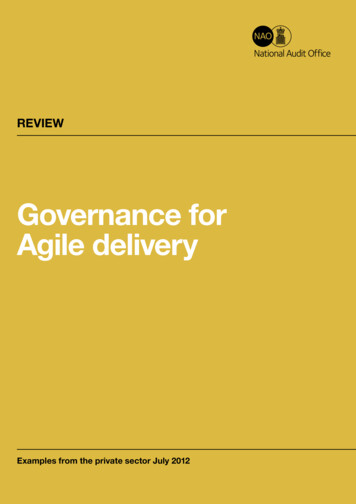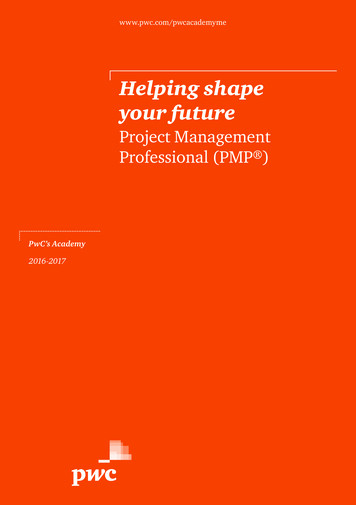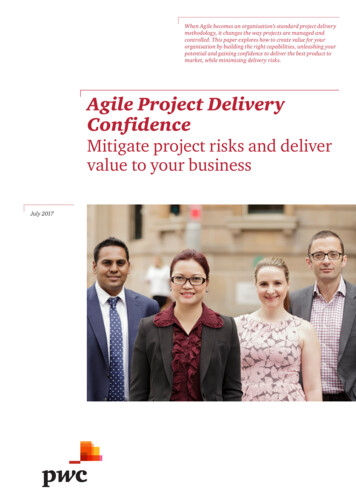
Transcription
When Agile becomes an organisation’s standard project deliverymethodology, it changes the way projects are managed andcontrolled. This paper explores how to create value for yourorganisation by building the right capabilities, unleashing yourpotential and gaining confidence to deliver the best product tomarket, while minimising delivery risks.Agile Project DeliveryConfidenceMitigate project risks and delivervalue to your businessJuly 2017
ContentsCreate value for your organisationwith Agile Project Delivery1Build Agile Project Deliverycapability4Unleash your organisation’spotential by becoming Agile8Do you have delivery confidence?What’s next?10Contacts12
Create value for your organisationwith Agile Project DeliveryThe case to transitionto AgileTo be competitive in today’s marketplace –in any industry – organisations must deliveran exceptional customer experience.Speed, quality, prioritisation, disciplineand adaptability are all key qualities thatwill engage customers and otherstakeholders to use products or servicesand build lasting relationships.Traditional project managementmethodologies, especially in today’sfast-paced digital world, are no longer aseffective in being responsive to a customer’schanging needs. To succeed in anenvironment with shifting demands,a business needs to be adaptive andreceptive to change.In response, many organisations areadopting various Agile Project Deliverymethods, suitable for their organisation.Agile Project Delivery is a value-drivenapproach that can give organisations thecapacity to deliver high-priority, highquality work and create lastingmeaningful relationships with theirstakeholders and customers. It ensures thedelivery of products through disciplined,proven practices and allows foradjustments based on continuousstakeholder and customer feedback,thereby increasing speed to market.“When Agile becomes an organisation’sstandard project delivery methodology, itchanges the way organisations manageand control projects. Each organisationadopting Agile must consider that this isnot just a software delivery method –Agile requires a significant shift inbehaviours that directly affectgovernance, human resources, riskmanagement, internal controls andbenefits management.Agile: providing valueAgile Project Delivery promises to providevalue to organisations because it hascontrols that ensure the product is drivenby the business, reducing the risk ofbuilding the wrong product.One common adage in the IT industry isthat 80 percent of all end users generallyuse only 20 percent of a softwareapplication’s features. Agile addresses thisby focusing on creating the minimumviable product (MVP) by delivering theminimum set of features that will deliverperceived value to the users1. The MVPalso allows them to continuouslyincorporate feedback into each futureiteration as more information aboutthe product becomes available, andadded to the minimum features required(by the users).A significant percentage of companies arenow using Agile Project Delivery as theirapproach to meet market demands.Although Agile projects are 28% moresuccessful than traditional, they still havea level of risk that can be addressed byhaving the right controls in place to helprealise business value, reduce the risk ofbuilding the wrong product, and increaseoverall development success2.If you are adopting an Agile Project Deliveryapproach, this paper can help. It exploreshow to create the best value for yourorganisation by building the rightcapabilities, unleashing your potential andgaining confidence to deliver the bestproduct to market, while minimising risksand implementing controls early and often.Agile and DevOps willdominate This cross–functional iterativeapproach to experiencedesign and delivery willbe a big shift – fraughtwith false starts andmissteps along the way– but will successfullylay the groundwork forsustainable customerled innovation3. ”Forrester’s 2017 Predictions1. Rooney, Paul (2012, Oct 3). Microsoft’s CEO: 80-20 Rule Applies To Bugs, Not Just Features. .htm2. Sweeney, Michael. (2014, Dec 4). Agile vs Traditional: Which Method is More Successful?. ethod3. Guarini, Matthew, Leaver, Sharyn, Matzke Pascal. Forrester Research. (2016, Oct 31). Predictions 2017: CIOs Push For Speed Amid Volatility. cios-push–for-speed-amid-volatility/PwC Agile Project Delivery Confidence 1
What is distinctive about Agile Project Delivery?Agile Project Delivery is based on four values:PeopleoverProcesses and toolsWorking prototypesoverExcessive documentationCustomer collaborationoverRigid contractsResponding to changeoverFollowing the planThese four values originate from the AgileManifesto, written in February 2001 by 17independent-minded softwarepractitioners. They set the tone for asuccessful project, especially at anorganisational level.Embedded into every facet of Agile ProjectDelivery, these values start with theorganisation’s overall cultural mindset –the most significant distinction betweenAgile and traditional project delivery.Other key distinctions between traditionaland Agile Project Delivery are: 2 Agile Project Delivery Confidence PwCA dedicated product owner isresponsible for making all decisions onany software features that should bedeveloped. These features are chosenbased on the value they deliver inmeeting established Key ProjectIndicators. Each team is assigned anindividual who comes from thebusiness – someone with the authority,time and trust to be effective inenabling change. Without a dedicatedproduct owner, Agile projects will sufferfrom delays in the decision makingprocess, something more common in atraditional hierarchical structure. Teams are 100% dedicated to theproject, thereby reducing multi-taskingand creating a high level of focus.Additionally, team co-location isrecommended as it creates efficienciesin communication, knowledge transferand team building. If we consider thebest teams in the world – be it a sportsteam or a software team – people whowork together build trust and performbetter than rotating teams.There are many other distinctions,including iterative and incrementaldevelopment, short feedback loops andcontinuous engineering practices, all ofwhich are designed specifically to increasedelivery value and satisfy stakeholders.
Traditional vs. Agile viewof project deliveryThese charts show the distinction betweena traditional and Agile project over thesame period of time.Traditional project deliveryRequirementsDesignDevelopmentTestingAgile reduces complexity by breakingdown the typical long cycle of a traditionalproject into one to four week cycles, callediterations, containing small, user-readysegments of the final product that weredeveloped and tested during the iteration.Although risk still exists in both, the mainoutcome is that Agile Project Delivery hasa working product after each iteration.This product improves throughout therelease due to the continuous feedbackthat is incorporated at several points inthe lifecycle.ImplementationMonth 1Month 2Month 3Agile project DevelopingMonth 1Finished ProductMonth 2Month 3Different Software Development Life Cycle, but risks remainAgile is designed to minimise the risk to deliveryGreater visibility lower riskTraditional approachVisibilityRegardless of the delivery method used,the core underlying project tasks,dependencies and environmentalsensitivities remain the same. Agile is nota silver bullet. There are still risks, butwhen doing Agile Project Delivery, theteam has the opportunity to respondto risk earlier in the delivery lifecycledue to ongoing visibility andcontinuous VisibilityAgile approachIn these two images, traditionaldevelopment has high visibility at thebeginning and end. This is often whyprogress reports are green until the end ofthe project where stakeholders once againhave visibility and realise that progresshad not been as expected. Agile, on theother hand, mitigates this risk throughiterative delivery where visibility is clearthroughout the lifecycle.Full Cycle (Requirements, Design, Implementation, Verify)PwC Agile Project Delivery Confidence 3
Build Agile Project Delivery capabilityThe benefits and challengesof Agile Project DeliveryAgile is also about embedding thefollowing characteristics into theapproach:Two strengths of Agile Project Deliveryinclude the flexibility to realign theproject work and the accelerated release ofincremental functionality. Collaborative, empowered and selforganising teamsFor an organisation attempting to do AgileProject Delivery for the first time, theapproach may appear to introduceanarchy rather than structure. Agile,being ‘non-prescriptive’ in nature, is opento interpretation and the implementationis only as good as how an organisationinterprets and enforces it. Visibility on progressOrganisational capabilities are multidimensional and embodied in theorganisation’s values and norms, managerialsystems, skills and knowledge, andtechniques and tools4. Changes can beexpected to all of these dimensions whenfirst embracing Agile Project Delivery. More automation to reduce waste Continuous code quality checksWithout these core characteristics inplace, the following may occur: Insufficient cultural acceptance Inadequate project organisationand governance Inappropriate use of the Agiletechniques and tools Ineffective risk and controltracking mechanismsBe ready to mitigate risksearly and oftenDespite the benefits of Agile ProjectDelivery, organisations may find theydo not have adequate or effective riskmanagement capabilities in place.Mitigating risk upfront andcontinuously throughout the project iswhat makes Agile Project Delivery theright approach.Agile Project Delivery is effective whenparticular delivery controls are inplace. Becoming an Agile organisationrequires top-down and bottom-uporganisational change to build newcapabilities to mitigate risks earlyand often. Inadequate level of changemanagement necessary for asuccessful Agile transitionAgile fosters a successful environment on many levels:Places a strong emphasis on prioritisingcustomer satisfaction through early andcontinuous delivery of valuableproducts and working software.Supports continuous attention totechnical excellence and gooddesign, leading to less waste.Reduces project delivery riskby engaging in frequent reviewswith a cross-functional line of sightinto product readiness, encouraginghigh stakeholder visibility.Fosters the importance of acollaborative, self-organising teamthat makes improvements, analysesproblems, and adapts behaviour tobecome more effective along the way.Welcomes changingrequirements, which encouragesrapid and flexible responses to change.Encourages clear expectations for eachcycle and a common understandingacross all teams of what constitutesdone and ready for delivery.4. Leonard-Barton, Dorothy (1992). Core Capabilities and Core Rigidities: A Paradox in Managing New Product Development [PDF Document]. Retrieved from the Strategic ManagementJournal, Vol. 13: https://business.illinois.edu/josephm/BA545 Fall%202011/S12/Leonard-Barton%20(1992).pdf4 Agile Project Delivery Confidence PwC
There is a correlation between project riskand speed of delivery. The faster a teamdevelops a product, the more inherentthe risk.Agile requires a highly-disciplined andfocused management and governanceapproach that provides near real time riskassurance through a range of Agileceremonies, such as: Iteration planning – Starting eachiteration where the team commits to agoal and identifies the requirements,helping them reach that goal withinthe iteration Retrospectives – A meeting at the end ofeach iteration where the team discusseswhat went well, what they could change,and how to implement those changes intothe next iterationPlan-Do-Check-ActRisks are identified and discussed withthe first (delivery team), second(Internal Audit) and third (externalaudit) lines of defence, and a mitigationplan is put in place in an iterative cyclecreated by W. Edwards Deming calledPDCA (Plan-Do-Check-Act). Product Backlog Refinement(Grooming) – An optional checkpointmeeting that is held near the end of asprint, where the product owner andthe team prioritise the backlog itemsand adjust accordinglyPlanDo Release planning – Planning the nextset of product features to release(comprised of multiple iterations) Reviews – A meeting at the end ofeach iteration, where a demo tocustomers and stakeholders is held topreview and discuss the functionalitythat was built in that iterationActAdapt delivery managementand governanceCheck Daily stand-ups – A 15-minutemeeting held each day in an iteration,where the development team discusswhat they completed the day before,what they will complete on the currentday, any dependencies, and anythingstanding in their way to complete a taskPlan – Establish objectives relevant formanaging riskDo – Implement controls to manage riskCheck – A ssess and measureperformance against controlsAct – Take corrective action and applyto the next iteration/releaseControl the riskSpecific control mechanisms providetouch points during Agile ProjectDelivery. These concentrate on keyaspects on the project lifecycle, asoutlined in this table.TouchpointDescriptionControl mechanism1Strategy and governanceplanning review Agile contract review Business case review Approach suitability review Agile risk assessment Stakeholder assessment23Requirements review(multiple reviews) Risk adjusted product backlog reviewBuild and test review(multiple reviews) Agile ceremonies/processes review User story review Test strategy/approach review Test automation review4Readiness and releasereview Code readiness review User readiness review (organisation and IT) Risk, compliance and control readiness Data conversion/migration review Business handover review (Definition of Done)5Post go live review Post implementation review/Projectretrospective6Overall portfolio/enterprise level Agile maturity assessmentPwC Agile Project Delivery Confidence 5
Accelerate risk assuranceto the speed of AgileAlthough the phases that occur intraditional project delivery still occur inAgile Project Delivery, they are brokendown into smaller iterations andincrements. The rigour in governance andcontrols occurs at a more frequent rate. Creating a modular approach togovernance procedures to align withincrement, release and roadmapsIn order for these controls to be effective,changes must occur top-down by leadershipand bottom-up by the project team. Anorganisation will need to assess and reviseits project delivery controls, including: Treating Agile meetings as a form of aself-organising team approval tomove forward daily and weekly withproject work Updating the change management processand defect management process to alignwith product backlog maintenance Updating reporting that tracks progressfor budget and schedule estimations Ensuring that the stakeholders and theAgile team are receiving the propertraining to be effectiveThis table describes the types of controls across the project lifecycle:Requirements and designDevelopmentQuality assessment Product and iteration backlog Version control code repository Testing as part of Definition of Done User stories Definition of Done increments Enforced workflows Definition of Done Adherence to coding agreements Product owner acceptance Cross competence fixed team Least viable productRefine your risk toolsand techniquesAgile Project Delivery includes many toolsand techniques to help control typicalrisks, such as:SWOT analysis (Strengths,Weaknesses, Opportunities, Threats) Avoid: Eliminate the risk entirely bychoosing an alternate approachProbability analysis A determination of whether the risk ishelpful or harmful to the project Assume: Accept the risk with noother action A list of a project’s top risks, theprobability of the risk occurring and theimpact of that risk to project deliveryOnce risk has been identified, the teamdiscusses what risk response strategyshould be used: Transfer: Redistribute the risk toanother areaRisk burndown chart Mitigate: Actions to reduce theprobability or impact of a risk inthe future A graphical representation of how thetotal risk value changes over time6 Agile Project Delivery Confidence PwCThe product backlog is then reprioritisedaccordingly, becoming a risk adjustedbacklog where the actions for the risks aredocumented and monitored.
Take a top-down andbottom-up approachBecoming Agile is achieved throughaligning delivery with strategy, enhancingtechnical capability, transforming yourpeoples’ mindset and accelerating theprocess execution.Here are a few considerations to help youreach each objective: Build short release cycles,frequent demos and continuousbusiness involvement Prioritise projects and stories based onbusiness value in alignment withorganisational strategy Update the change and defectmanagement process to align withproduct backlog maintenance Decentralise decision making to reducedelays and achieve fast value delivery Enable continuous learning through‘inspect and adapt’ to ensurelessons learned are incorporated Agree on an approach for Agile ProjectDelivery and determine that the rightmeasurements related to Agile valuesand principles are followedAccelerateprocessexecution Invest in coaching to develop theAgile mindset and providecontinuous training on methodsand practices Foster a culture of opencollaboration and communicationTransformpeoplemind set Minimise risk through frequent demosand encourage stakeholder feedback Empower the product owner to makethe go/no-go decision for each productreleaseBecomeAgile Build cross functional, selforganising, fully committed andmotivated teams Improve employee engagement byproviding autonomy, mission andpurpose and minimise constraintsAligndelivery withstrategy Provide greater visibility through periodicmonitoring of Velocity and Burndowncharts to assess delivery riskEnhancetechnicalcapability Remove barriers to the productivity ofdevelopment by applying more rigouraround automation, source controland provisioning Drive the process of continuouslyintegrating code changes from Agileteams in shared code basedenvironments Build in quality through automatedcode reviews and refactoring Leverage Agile tools for management,support, collaboration and reportingin a transparent and efficient wayPwC Agile Project Delivery Confidence 7
Unleash your organisation’spotential by becoming AgilePoints to consider on yourpath to Agile Project DeliveryDetermine organisational readiness andcultureIs your organisation ready to embrace anAgile transformation? Does the leadershipstyle support it? Are the delivery team andInternal Audit ready to embrace Agile?Agile is about preparing your organisationfor cross-team collaboration. Having anunderstanding of its readiness is animportant first step.Engage Internal Audit, Risk andCompliance and Technology teamsAgile has the capacity to fail, just like anyother technology transformation. This ismost likely to happen at the beginning dueto Internal Audit and Risk and Compliancenot being engaged at the outset.Are you sure these teams understand whatthe shift from traditional to Agile means?Have your technology delivery teamsreviewed and assessed the need to embedcontrols within Agile processes? Do bothsets of teams understand the value ofcollaborating to drive controlled AgileDelivery? If not, your transformation maybe challenged from the start.Assess existing controlsNot all current defined controls areapplicable and relevant to Agiledevelopment. Evaluating the relevance,applicability and maturity of currentcontrols is important in understanding howthey need to be redefined or implemented todrive value from the transformation.8 Agile Project Delivery Confidence PwCEvaluate your Agile maturityIf you’ve already begun to move towardsAgile, it is key to understand where thetransformation may be exposing yourorganisation to risk. Objectively assessingand understanding Agile team maturity isa critical point to identify and resolvegaps, accelerate process improvements,and evaluate control gaps and deficiencies.Identify Agile controlsPoorly designed or non-existent controlspose significant risk. A clear definitionand application of controls to Agiledevelopment processes are needed topreserve business integrity, promotequality control and comply withregulatory and organisational statutesand requirements.Evaluate tools and technologyAlthough Agile is not about technology,understanding how technology needs tobe modified or implemented to supportAgile and control effectiveness must beconsidered. Existing technology should beidentified and assessed to help inunderstanding how they support Agileprinciples and controls.Additionally, new technologies should beacknowledged so that Internal Audit andRisk and Compliance teams can begin tounderstand how their review andevaluation of Agile (from a control andcompliance lens) need to change.Prepare for DevelopmentOperations (DevOps)DevOps provide a framework to acceleratedelivery of completed solution componentsto production. Understanding DevOpsprinciples, tools and embedded controls ishelpful as your organisation seeks tomature and automate more development,code migration, and testing activities tomeet changing business needs.Successfully adopting and optimisingAgile delivery frameworks often includesa transition to DevOps. DevOpsaccelerates deployment by removing thetraditional barrier between thedevelopment and operations activities andtools. This presents a continuousintegration environment, where all code iscontinuously integrated and synchronised.In many cases, it also automatesdevelopment builds, migrations andtesting activities.Successfully integrating Agile withDevOps practices and tools is essential togetting a product to market quickly andfacilitating Internal Audit’s review ofAgile projects.
Develop skills and knowledge within theAgile Project Delivery teamDevelop Agile Project Deliverytechniques and toolsWhen properly developed, the AgileProject Delivery team includes dedicatedteam members and stakeholders who fullyunderstand Agile Project Delivery culture,governance, tools and techniques.Agile organisations should alsoincorporate tools and techniques that helpopen and align communication channelsbetween stakeholders, including:Agile teams will best deliver value whenthey are cross-functional, e.g. a softwaredeveloper who can do testing and writetechnical documentation. Cross-functionalteams are more resilient and increaseefficiency by reducing hand-offs.Agile Project Delivery demands a highlevel of personal interaction and frequentinformal communication, teams are mostlikely to succeed when members areco-located.Clearly establishing roles is important.The identification of a single, dedicatedproduct owner is key to breaking down thebarriers between the development team andthe organisation.A new product owner must: Have the necessary time to spend withthe Agile team to answer questionsand refine user stories Have the authority to definerequirements/stories, and formallyaccept the product as ‘ready fordeployment’ on behalf of the organisation A continuously prioritisedproduct backlog A clearly defined and socialised(enterprise) ‘Definition of Done’ A set of acceptance criteria prior to thestart of development Daily review of quality to enableexpedited code deployments Efficient ceremonies to support andenhance Agile delivery Structured review, approval andprioritisation of user stories/requirements by the product owner Automated testing and continuousintegrationThis ensures that the features aredeveloped in accordance with theirpriority, minimising business risk andincreasing business value.Agile Project Delivery also continuouslyprioritises, consumes and delivers themost valuable stories (requirements)during each iteration. Ensure the product backlog iscontinuously updated and correctlyprioritised based on business needs Actively participate in Agileceremonies, e.g. planning meeting,demos and retrospectives Work with internal and externalstakeholders to validate that thecorrect controls are in place, e.g. Legal,Compliance, Risk, Internal AuditPwC Agile Project Delivery Confidence 9
Do you have delivery confidence?What’s next?PwC’s Agile DeliveryConfidence FrameworkWe use this framework to:We use a comprehensive framework toprovide delivery confidence to Agileorganisations, underpinned by ourunderstanding of Agile and experience inglobal transformation projects. Fullyimplemented, our Agile DeliveryConfidence Framework creates assuranceover risk that operates at the speed of yourAgile Project Delivery.While the framework is aligned with Agilevalues, it assesses against the essentialelements of project management,governance, cost and measurement ofvalue delivery. We can perform differenttypes of reviews to assess risks andidentify mitigation actions across theproject lifecycle. Provide assurance to Management,Sponsors, IT, Risk, and Internal Auditon Agile governance, controls, cultureand change management Provide safeguards to the deliveryteam and Internal Audit so that theycan provide assurance, while beingenablers of Agile Embed the core fundamentals of whatit means to be Agile, through trainingand coaching, including steps toreduce project risks right from the startTo help an organisation navigate through avolatile risk environment, we can providethe right balance and understanding ofrisk, controls and expertise. Provide maturity assessments tounderstand Agile team deliverycapabilities, gaps and maturity towardsbecoming a high performing team Help organisations build their AgileCentres of Excellence by creating theright governance and culture aroundthe methodologyPwC's Agile Delivery Confidence Framework: assessing elements of projectmanagement, governance, cost and measurementSatisfy customerWelcome Create and deliver business value Minimise delivery riskValue deliveryGovernanceenablingdecision makingProgressiveplanningMethodology lenceCost anorg sSelf teamSelf tedsuppliersexcellenceInspect andadaptAgile practicesand techniquesSustainabledevelopment10 Agile Project Delivery Confidence PwCsseealetruenFreqFco acemm toun faceicationCustomercollaborationMotivated individualsInspect and adaptManagedrisk andopportunitiesWhen done well, Agile ProjectDelivery has the potential to:grkinWos areres ftwog soPrWorkingtogetherityplicSim Confirm that expected benefitsare realised Increase the level of acceptanceby key stakeholders Better manage stakeholderexpectations through demos andproduct reviews
Achieving the full value from Agile ProjectDelivery requires continuous planningand a commitment to proactive andembedded assurance and controls as partof an Agile transformation.Agile DevelopmentOperations (DevOps)MaturityUnderstanding your Agile and DevOpsmaturity is a critical step to understandingAgile gaps that could be impactingbusiness delivery.Our Agile Project Delivery practitioners canhelp provide insight and perspective onchallenges impacting Agile maturity.How we can help youHow we can helpProvidefoundational andin-depth AgiletrainingDevelop controlsframeworks forAgile projectsProvide AgileconsultingConduct AgilematurityassessmentsHelp controlfunctions to betterenable AgileteamsPerformprogramme/project riskassessmentsDeliver ongoingcoachingAssess currentSoftwareDevelopment LifeCycle and AgilemethodologiesAssess controlmechanismsOur assessments: Analyse team maturity using speciallydesigned Agile maturity assessmentframeworks Develop or confirm existing maturityaction plans for achieving the nextstage of maturity Understand the use of the Agile/DevOps tool by delivery teams,including the availability of metrics toaid more continuous visibility intomaturity level and progression Conduct interviews with a balanced setof select team members to furtherdevelop understanding of Agile/DevOps maturity Observe team ceremonies as key inputsto the execution of Agile principlesand conceptsThe assessment generates a detailed list offindings, as well as a tailored roadmaptowards optimising and improving Agile/DevOps maturity.The journey to Agile Project DeliveryAgile transformations are complex. Successfully designing, adopting and executing an Agiletransformation requires significant planning, review and organisational readiness.Navigating the journey to Agile success requires a level of due diligence, insight and anunderstanding of Agile delivery frameworks.We have the experience and insight to help your organisation succeed on its journey. With theright Agile processes, tools, principles, mindset and willingness to innovate, your organisationwill reap the rewards of stakeholder satisfaction and realise the benefits of a project modelledaround continuous improvement and organisational growth and evolution.PwC Agile Project Delivery Confidence 11
AuthorsContact your local Risk Assurance team to find out how we can help you achieve successwith Agile Project DeliveryCanadaAustraliaCanadaGanesh JonnalagaddaSarah ShafeyWes wc.comGermanyGermanyGermanyMarco MassettiPatrick MaertenSimon on.wieczorek@pwc.comNetherlandsSwitzerlandUnited KingdomSander LandzaatManuel ProbstAndrew .schuster@pwc.c
Agile and DevOps will dominate This cross– functional iterative approach to experience design and delivery will be a big shift – fraught with false starts and missteps along the way – but will successfully lay the groundwork for sustainable customer led innovation3. Forrester

